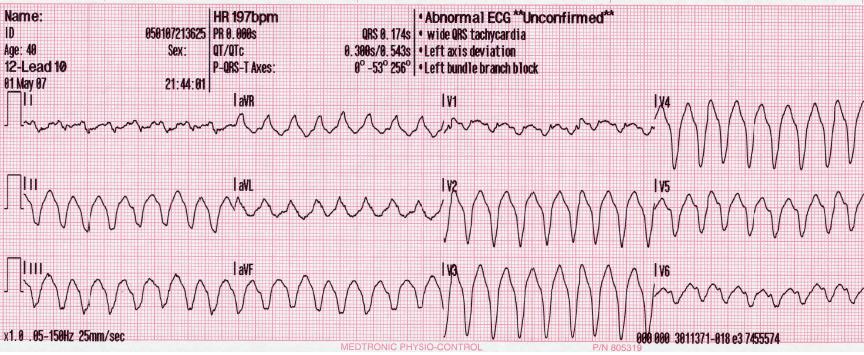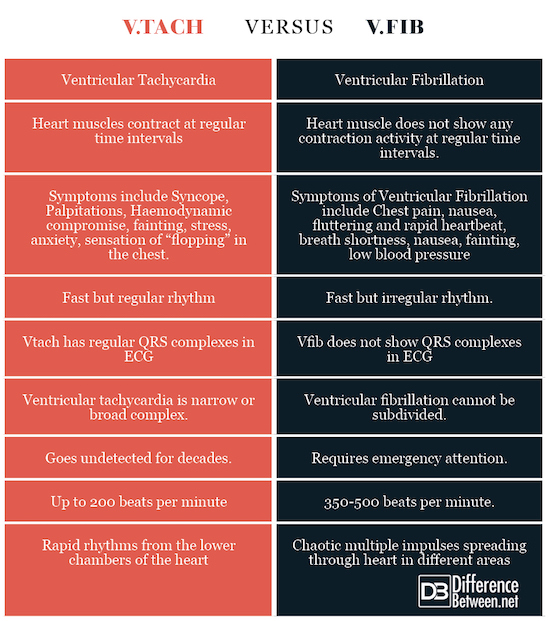Difference Between Ventricular Tachycardia (Vtach) and Ventricular Fibrillation (Vfib)
What are Ventricular Tachycardia and Ventricular Fibrillation?
Ventricular Tachycardia and Ventricular Fibrillation are both a group of conditions where the heartbeat is irregular, too slow, or too fast. Such conditions are known as Heart arrhythmia.
Ventricular Tachycardia (vtach): Overview
Ventricular Tachycardia is a medical condition wherein the electrical impulses produced in the SA node are substituted by an ectopic pacemaker. This condition can also result due to intake of recreation medical drugs. The heart tissues will show contraction activity at regular time intervals but at a very escalated rate, mostly more than hundred beats/minute.
Ventricular Fibrillation (vfib): Overview
Vfib is the most serious arrhythmia and is an uncontrolled, irregular heartbeat. Instead of one missed heart beat from the ventricles, individual experiences several impulses that start simultaneously from different places – all commanding the heart to beat. The heart beats are very fast, chaotic, irregular and sometimes reach three hundred beats/minute. Ventricular Fibrillation is a condition where the electrical impulse conducting system functions in a haphazard manner. There is no coordination between the contraction activity, that triggers irregular rhythms in irregular time intervals. Here, rate and rhythm both get impacted unlike in tachycardia. Ventricular Fibrillation is a serious medical disease which if not treated immediately after it is diagnosed, leads to death.
Difference between Ventricular Tachycardia and Ventricular Fibrillation
Definition
Ventricular Tachycardia (vtach)
Ventricular Tachycardia is a medical condition which is associated with the hearts irregular electrical impulses. Such a condition arises mostly in people having valvular hear disease.
Ventricular Fibrillation (vfib)
Ventricular fibrillation (VFib) is a medical condition in which the heart beats in an abnormal rhythm. The lower heart chambers show quivering activity and the heart is unable to pump any blood, leading to cardiac arrest. Vfib is an emergency condition that is triggered by a heart attack.
Causes
Ventricular Tachycardia (vtach)
The exact factor causing ventricular tachycardia is actually unknown. However, in most of the cases, it is triggered by some other hear disorder.
Some medical conditions that trigger ventricular tachycardia include:
- Cardiomyopathy – chronic disease of the heart muscle.
- Congestive heart failure (when the heart is not able to pump properly to maintain blood flow to meet the body’s requirements).
- Structural heart disorder (cardiac defects which are congenital in nature that results due to previous heart attack).
- Ischemic heart condition (that results because of interrupted flow of blood to the heart).
Several categories of Vtach are genetic, which means the medical issue passes down from a parent to a kid. These are:
- Catecholaminergic polymorphic ventricular tachycardia
- Arrhythmogenic right ventricular dysplasia
Ventricular Fibrillation (vfib)
Certain causes of vfib include:
- Heart failure
- Coronary artery disorder (Shock)
- Aortic dissection
- Cardiomyopathies
- Aortic stenosis
- Myocarditis
- Electrical shock (injury caused by electric current)
- Sepsis (severe body infection)
- Drowning
- LQTS (ventricular myocardial repolarization).
- Medical drugs that impact electric currents in the heart (such as Na or K channel blockers).
- Brugada syndrome (ECG abnormality resulting in sudden death in patients with structurally normal hearts)
Risk factors
Ventricular Tachycardia (vtach)
Any medical disorder that induces strain or any kind of pressure on the heart cells or damages heart linings can increase the risk of ventricular tachycardia. Improved lifestyle patterns or medical treatment can alleviate the risks associated with the below mentioned factors:
- Heart disorders (for example, previous heart attack, inflammatory disorders of heart or some birth defects in heart and hypertrophic cardiomyopathy (a condition wherein a portion of the heart becomes quite thick without any obvious cause)
- Intake of recreational drugs (psychoactive drugs consumed to induce a modified consciousness for pleasure)
- Extreme electrolyte deformities
- Side effects of certain medical drugs
Other risk factors:
In case, an individual has a family history of vtach or some other heart issues, he is at a higher risk of ventricular tachycardia.
Ventricular Fibrillation (vfib)
Characteristics that may escalate your risk of ventricular fibrillation include:
- A prior event of ventricular fibrillation
- Already suffered heart attack
- Malfunctioning of heart since birth (congenital heart disease)
- Cardiomyopathy (disease of heart muscle)
- Damage to heart cells because of electrocution
- Intake of illegal drugs, like cocaine and methamphetamine
- Notable electrolyte deformities, like with K or Mg
Treatment
Ventricular Tachycardia (vtach)
Treatment for Ventricular Tachycardia include:
- Vagal maneuvers
- Cardioversion
- Radio-frequency catheter ablation
- Anti-arrhythmic drugs
Medications:
- Antiarrhythmic agent
- Beta blocker
- Blood pressure support
Ventricular Fibrillation (vfib)
Treatment for Ventricular Fibrillation include:
- cardiopulmonary resuscitation – CPR and
- shocks to the heart with a medical instrument called an automated external defibrillator (AED)
- Arrhythmia medications
- Defibrillation.
- Coronary angioplasty and stent placement.
Medications:
- Blood pressure support,
- Antiarrhythmic agent, and
- Dietary supplement
Frequency
Ventricular Tachycardia (vtach)
~7% of people in cardiac arrest
Ventricular Fibrillation (vfib)
~10% of people in cardiac arrest
Diagnosis
Ventricular Tachycardia (vtach)
- Electrocardiogram (ECG)
- Cardiac MRI (CMRI)
- Transoesophageal echocardiography
Ventricular Fibrillation (vfib)
- Electrocardiogram (ECG)
- Blood tests
- Chest X-ray
- Echocardiogram.
- Coronary catheterization (angiogram)
- Cardiac computerized tomography (CT)
- Magnetic resonance imaging (MRI)
Summary of V.Tach and V.Fib
The points of difference between Ventricular Tachycardia and Ventricular Fibrillation
have been summarized below:
- Difference Between Global Warming and Greenhouse Effect - May 18, 2024
- Difference Between Vaccination and Immunization - March 3, 2024
- Difference Between Selective Mutism and Autism - February 25, 2024
Search DifferenceBetween.net :
Leave a Response
References :
[0]Image credit: https://commons.wikimedia.org/wiki/File:De-Rhythm_ventricular_fibrillation_(CardioNetworks_ECGpedia).png#/media/File:De-Rhythm_ventricular_fibrillation_(CardioNetworks_ECGpedia).png
[1]Image credit: https://upload.wikimedia.org/wikipedia/commons/4/45/12_lead_generated_ventricular_tachycardia.JPG
[2]Denniss, A. R., Ross, D. L., Richards, D. A., Holley, L. K., Cooper, M. J., Johnson, D. C., & Uther, J. B. (1988). Differences between patients with ventricular tachycardia and ventricular fibrillation as assessed by signal-averaged electrocardiogram, radionuclide ventriculography and cardiac mapping. Journal of the American College of Cardiology, 11(2), 276-283.
[3]Koplan, B. A., & Stevenson, W. G. (2009, March). Ventricular tachycardia and sudden cardiac death. In Mayo clinic proceedings (Vol. 84, No. 3, pp. 289-297). Elsevier.
[4]Weiss, J. N., Chen, P. S., Qu, Z., Karagueuzian, H. S., & Garfinkel, A. (2000). Ventricular fibrillation: how do we stop the waves from breaking?. Circulation Research, 87(12), 1103-1107.



